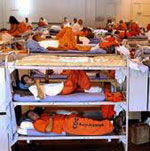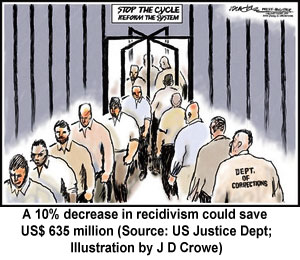
The US jails more of its own people than any other Western country

FRONT PAGE
About us
 

Rehabilitation of ex-felons in the US
American policing
Character education
America jails its youth
Youth curfews in US cities
US teachers face scrutiny
Character education
US school discipline & civil rights

Worldwide | Elections | North America | Latin America | Europe | Asia | Africa |


 




 













|
|
Increasing number of US cities
end stigmatization of ex-felons
By Tony Favro, USA Editor
22 June 2014: The US government’s War on Drugs began in the 1970s. Drug possession and use were seen as gateways to crimes such as burglary, robbery, assault and prostitution, as well as to the breakdown of families and neighborhoods. Prisoners of the federal War on Drugs received draconian prison sentences, mandatory minimum sentences, and no parole for nonviolent and victimless crimes.
By the 1990s, with crime continuing to rise, a ‘zero tolerance’ mentality overtook American criminal justice. Schools, public housing, and workplaces aimed to be totally free of crimes and criminals. Application forms for a wide range of opportunities increasingly asked whether the applicant had been convicted of a crime. Checking the ‘yes’ box most often meant an applicant would never be considered, regardless of his or her qualifications.
Over the past decade, several American cities have been taking steps to mitigate barriers to the constructive re-entry of former felons into society. Fifty-three US cities and nine counties no longer allow a question on employment applications asking if a person has ever been convicted of a felony offense. The pace is quickening, with eight cities and counties ‘banning the box, in the first quarter of 2014.
 Philadelphia story Philadelphia story
Mayor Michael Nutter expressed his support for a successful Ban the Box ordinance in Philadelphia by explaining, “We’re working every day to offer a level playing field to qualified individuals who have paid their debt to society. Everyone deserves the opportunity to work to provide for their families and should not be discriminated against before they even have a first interview. Offering jobs to ex-offenders improves the quality of life for all Philadelphians.”
The number of people affected is sobering. Each year, Philadelphia jails release over 30,000 inmates, and Pennsylvania state prisons release another 5,000 inmates on the streets of Philadelphia, most of whom served short terms for drug-related crimes.
The Philadelphia story is repeated nationwide. About 650,000 ex-offenders are released from federal and state prisons each year and another 700,000 from city and county jails. One out of every four adults in the US currently has an arrest or criminal record. And the vast majority of ex-offenders were remanded to prison with sentences of 18 months or less for nonviolent drug offenses.
More and more US mayors consider Ban the Box legislation an important aspect of their overall employment and public safety strategy. They realize that people permanently locked out of the job market often turn to crimes of survival or public assistance or under-the-table work, where they are underpaid and exploited—all of which makes their cities less safe and less economically viable. Mayors in large, medium, and small cities, including New York City, Chicago, St. Paul, Minnesota, Kalamazoo, Michigan, and Wilmington, Delaware, have banned the box through executive order or mayoral directive. They risked being labeled ‘soft on crime’ by their political opponents because banning the box is “the right thing to do”, according to former Mayor Richard Daley of Chicago. For two-thirds of the communities that currently ban the box, the law applies only to employment by city government or contractors employed by the city; for the other third, private employers must also ban the box.
 Benefits Benefits
Supporters of legislation to remove questions about previous crimes from employment and other applications, including the National Employment Law Project, offer several reasons to ban the box:
• Reduce recidivism and increase public safety. Employment is the single most important factor in preventing recidivism. New York State, with one of the largest prison populations in the US, has a recidivism rate of 40 per cent; however, formerly incarcerated people with one year of employment have an 8 per cent recidivism rate. Even 30 days of employment lowers the chance of reoffending by 20 per cent, according to the New York State Division of Criminal Justice Services. The cost to taxpayers to jail one inmate in a New York State prison for one year is $60,000, according to the Vera Institute of Justice.
• Revitalize local economies. When people cannot work, they cannot care for their families nor spend money on the basic services that drive local economies. People who face structural barriers to employment often must resort to public assistance or survival work, and taxpayers pay the bill. The Economy League of Philadelphia found that putting 100 formerly incarcerated people back to work could increase their lifetime payroll tax contributions by approximately $2 million, boost sales tax revenues by nearly $800,000, and save $2 million annually to keep them out of the criminal justice system.
• Give jobs to qualified individuals. The City of Minneapolis passed a Ban the Box ordinance in 2006, one of the first in US. A recent analysis by the City found that over 50 per cent of qualified applicants with criminal records were hired, and that removing the box from application forms did not delay the hiring process or create additional work for the City’s Human Resources department, which is responsible for hiring, training, and retaining employees. In Durham County, North Carolina, the number of applicants with criminal records that were recommended for hire increased nearly 300 per cent two years after Ban the Box legislation passed, and 97 per cent of those recommended were eventually hired.
Housing
If efforts to make applications reflect the real lived experiences of everyday people are gaining traction in the realm of employment in the US, they are lagging in other areas. Many American cities, for example, require landlords to use a ‘crime-free’ lease. In other words, a tenant can be evicted for any criminal activity related to the tenant’s household, even if the tenant was not personally involved or was a victim of the crime. Landlords are often required to perform criminal background checks on prospective renters and evict tenants that generate police service calls.
When a woman in the Borough of Norristown, Pennsylvania (population 34,000) called police because she was being physically abused by her live-in boyfriend, the police threatened to remove her from her apartment. According to Norristown’s nuisance property ordinance, local police could force tenants out of their rental units after three instances of disorderly behavior within four months. Because of the threats of eviction, the woman did not call for help the next time she was being abused and ended up in the hospital from her injuries. Ultimately, she had to sue the Borough to remain in her home.
Under the pressure of lawsuits, Norristown repealed the ordinance and replaced it with a new version by which landlords face increasing penalties if they fail to evict tenants with repeated instances of disorderly behavior. According to a spokesperson for the American Civil Liberties Union, which sued Norristown in federal court on the tenant’s behalf, “It was clear even to Norristown that a government entity cannot unilaterally kick someone out of their home without due process, so instead, they are trying to kick people out of their homes without due process by penalizing landlords if they don’t evict.”
Due process is a constitutional guarantee in the US that the government will respect the rights of the individual to life, liberty, and property. As such, the government must prove it is balancing the needs of the community with the rights of the individual, or risk being held liable. In 2010, the Village of East Rochester, New York (population 6,600) paid $100,000 to settle claims by two tenants who failed to contact police despite being abused domestically for fear of eviction.
No one wants to live in crime-infested neighborhoods; however, crime-free leases and zero-tolerance ordinances can, in some cases, deter tenants and landlords from asking for police assistance, lead to the eviction of crime victims and those with behavioral disabilities, increase homelessness, and reduce the supply of affordable housing. At the same time, they may undermine the public safety and quality of life goals they were intended to achieve.
Mayoral leadership
It’s a tough balancing act to allow people with a conviction history to compete fairly for employment, housing, and other opportunities without compromising safety and security. The vast criminal justice machine created by the War of Drugs almost ensures that large numbers of Americans will have criminal records, even as the federal and state governments find ways to release more and more inmates from prison each year. Ultimately, the burden is on local governments to help former offenders find jobs, housing, and other re-entry points into society.
A lesson from the War on Crime is that crime plays out in ways that are too complex for policymakers to have all of the answers. There is no way to avoid all the harms that can result from well-intended laws and programs. However, one near-certainty for US mayors is that removing the question about criminal history from job applications can reduce recidivism, crime, and poverty, and give ex-offenders a fair chance at becoming valuable assets to their communities.
The article includes information from Reyna Ramolete Hayashi, Esq., Empire Justice Center.
|
|

|































 Philadelphia story
Philadelphia story Benefits
Benefits